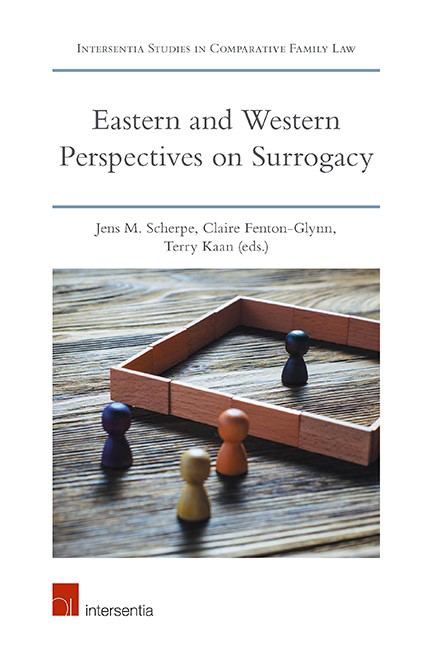Book contents
- Frontmatter
- Preface and Acknowledgements
- Contents
- List of Contributors
- Introduction
- Questionnaire
- PART I WESTERN PERSPECTIVES
- THE PROHIBITIVE APPROACH
- THE TOLERANT APPROACH
- THE REGULATORY APPROACH
- THE FREE MARKET APPROACH
- THE INFLUENCE OF INTERNATIONAL COURTS
- PART II EASTERN PERSPECTIVES
- THE PROHIBITIVE APPROACH
- A TOLERANT APPROACH?
- Hong Kong
- REGULATION THROUGH PROFESSIONAL MEDICAL BODIES
- FROM FREE MARKET TO REGULATION
- PART III COMPARATIVE PERSPECTIVES ON SURROGACY
- Index
- About the Editors
Hong Kong
from A TOLERANT APPROACH?
Published online by Cambridge University Press: 26 June 2019
- Frontmatter
- Preface and Acknowledgements
- Contents
- List of Contributors
- Introduction
- Questionnaire
- PART I WESTERN PERSPECTIVES
- THE PROHIBITIVE APPROACH
- THE TOLERANT APPROACH
- THE REGULATORY APPROACH
- THE FREE MARKET APPROACH
- THE INFLUENCE OF INTERNATIONAL COURTS
- PART II EASTERN PERSPECTIVES
- THE PROHIBITIVE APPROACH
- A TOLERANT APPROACH?
- Hong Kong
- REGULATION THROUGH PROFESSIONAL MEDICAL BODIES
- FROM FREE MARKET TO REGULATION
- PART III COMPARATIVE PERSPECTIVES ON SURROGACY
- Index
- About the Editors
Summary
In 2010, the Hong Kong public was shocked by media reports of Peter Lee, son of renowned tycoon Lee Shau Kee, and the triplets born to him in the United States through a surrogate mother. Surrogacy was catapulted to the forefront of public discussion. The particular controversy surrounding Peter Lee's triplets was due to multiple factors. For example, there was the fact that Peter Lee was a single father and that the triplets would thus grow up motherless, 1 as well as speculation that he had undergone sex selection to ensure that the triplets would be sons. 2 Given that the triplets had been born pursuant to a commercial surrogacy arrangement in the United States, there was also a question as to whether Peter Lee may have contravened any prohibition contained in the relevant legislation and committed an offence (discussed further below).
The following chapter aims to provide an overview of the regulation of surrogacy in Hong Kong. It begins with the general legal framework, tracing the historical development of the relevant legislation and then setting out its main provisions and prohibitions in relation to surrogacy. This is followed by an examination of the Council on Human Reproductive Technology and the Code of Practice it publishes, together with the eligibility requirements contained within. The latter half examines parenthood in Hong Kong and how it is transferred for the purposes of surrogacy arrangements.
GENERAL LEGAL FRAMEWORK
The legal framework for surrogacy in Hong Kong is largely contained within the Human Reproductive Technology Ordinance (Cap. 561) (‘HRTO’).
HISTORY OF THE HUMAN REPRODUCTIVE TECHNOLOGY ORDINANCE
Background
The historical development of the HRTO can be traced back to the 1980s. The first donor insemination service in Hong Kong was established in 1981, which led to the birth of the first baby conceived using in vitro fertilisation (‘IVF’) technology in 1986. 3 In response to these developments, the Secretary for Health and Welfare at the time set up a multidisciplinary Committee on Scientifically Assisted Human Reproduction in 1987.
- Type
- Chapter
- Information
- Eastern and Western Perspectives on Surrogacy , pp. 419 - 438Publisher: IntersentiaPrint publication year: 2019

